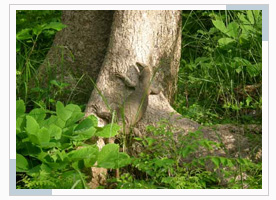Corbett National Park
General Information
| State | Uttaranchal |  |
| Location | 63-km Southwest of Nainital, Uttar Pradesh | |
| Area | 600 sq km (core area of 322 km) | |
| Best Time to Visit | February to May | |
| Altitude | 400 - 1200 meter above the sea level | |
| Temperature | 18.00°C | |
| Languages | Hindi, English |
Jim Corbett National Park has attracted the national and international tourists from all parts of the world for its credit of being one of the greatest National Parks of Asia with rich, rare, diverse wildlife, breathtaking landscapes and precious bio-diversity. The Park is sprawled over an area of five hundred and twenty acres of forests, hills and grasslands that provides an overview of the natural haven of flora and fauna that captured the imagination of the all the tourists. This park is heralded as India's first national park and the first sanctuary to come under Project Tiger! n image of a vanishing world.
History of Jim Corbett National Park
The history of this Park can be traced back to the period of British India when this park was used as the hunting ground. The foundation of the park was laid down in 1936, the park was announced as the First National Park of India, and its name was changed from Hailey National Park to the Ramganga National Park and finally to Corbett National Park after the name of the legendary hunter, naturalist, author and photographer who had given the idea of demarcating the park’s boundaries. It was in 1973, the Park was made one of the first sanctuaries in India under Project Tiger Scheme with the large population of the tigers, leopards, elephants etc.
Location
The geographical location of Corbett National Park is between 29°25' to 29°39' N latitude and 78°44' to 79°07' E longitude situated in the Indian State of Uttaranchal, which was carved out of Uttar Pradesh in 2000. Its location has also played an important role of the attractions of the tourists as the Corbett Park lies in the foothills of the Himalayas within the districts of Nainital, Pauri Garhwal, Almora and Binjore.
The Park is famous in the world not only for the Tiger Reserves but also for its rich biogeographical diversity with more than 600 species of the birds along with other wildlife animals like Himalayan Palm Civet, Indian Gray Mongoose, Common Otter, Blacknaped Hare and Porcupine, crocodiles on the banks of Ramganga River.
Special Attractions
Two destinations of the Corbett National Park are the major attractions of the tourists. First is Ramnagar a small town amidst the dense forests famous for the fishing camp and the sport buffs like angling. Another destination is the wildlife viewing that is through elephant safari and jeep safari.
Best Time to Visit
Generally, between November 15 to June 15, the park is flocked by the tourists because of the pleasant season. The Park remained closed from June 16 and November 14, when the monsoons flood the riverbeds and cut the fragile road links.





